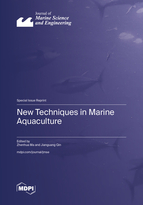New Techniques in Marine Aquaculture
A special issue of Journal of Marine Science and Engineering (ISSN 2077-1312). This special issue belongs to the section "Marine Aquaculture".
Deadline for manuscript submissions: closed (1 May 2023) | Viewed by 32610
Special Issue Editors
Interests: aquaculture; artificial breeding; larval fish; fish and shellfish physiology; fish behavior; diseases control; nutrition; recirculation system; pond culture; offshore sea cage
Special Issues, Collections and Topics in MDPI journals
Interests: aquaculture nutrition; biotechnology; water quality; algal culture; fish; mollusks; crustaceans
Special Issues, Collections and Topics in MDPI journals
Special Issue Information
Dear Colleagues,
The emergence of new techniques has driven the rapid development of aquaculture worldwide. This Special Issue updates the research and technological development of aquaculture in biotechnology, ecotechnology, feeding technology and environmental technology. Specifically, the coverage of this Special Issue includes biotechnology for the isolation and characterization of genes providing resistance to bacterial infection and environmental stress, feeding technology to improve immunity and stress resistance, the detection of thermal stress on marine fish immunity, light color manipulation to improve algal growth, and the use of integrated multi-trophic systems to improve production. This Special Issue uses recent research in marine fish, shrimp, sea cucumbers, sea urchins and algae to highlight new technological developments in aquaculture. These papers will lead to further research and extend these technologies to other species in aquaculture.
Dr. Zhenhua Ma
Prof. Dr. Jianguang Qin
Guest Editors
Manuscript Submission Information
Manuscripts should be submitted online at www.mdpi.com by registering and logging in to this website. Once you are registered, click here to go to the submission form. Manuscripts can be submitted until the deadline. All submissions that pass pre-check are peer-reviewed. Accepted papers will be published continuously in the journal (as soon as accepted) and will be listed together on the special issue website. Research articles, review articles as well as short communications are invited. For planned papers, a title and short abstract (about 100 words) can be sent to the Editorial Office for announcement on this website.
Submitted manuscripts should not have been published previously, nor be under consideration for publication elsewhere (except conference proceedings papers). All manuscripts are thoroughly refereed through a single-blind peer-review process. A guide for authors and other relevant information for submission of manuscripts is available on the Instructions for Authors page. Journal of Marine Science and Engineering is an international peer-reviewed open access monthly journal published by MDPI.
Please visit the Instructions for Authors page before submitting a manuscript. The Article Processing Charge (APC) for publication in this open access journal is 2600 CHF (Swiss Francs). Submitted papers should be well formatted and use good English. Authors may use MDPI's English editing service prior to publication or during author revisions.
Keywords
- aquaculture nutrition
- biotechnology
- water quality
- algal culture
- fish
- mollusks
- crustaceans







